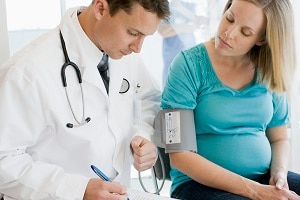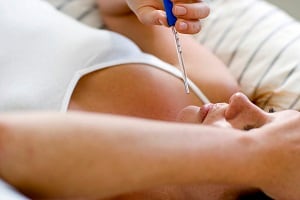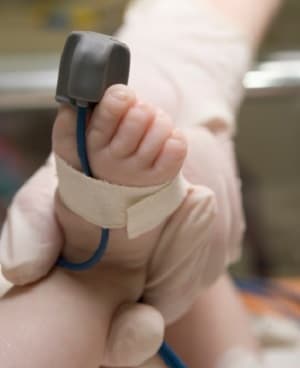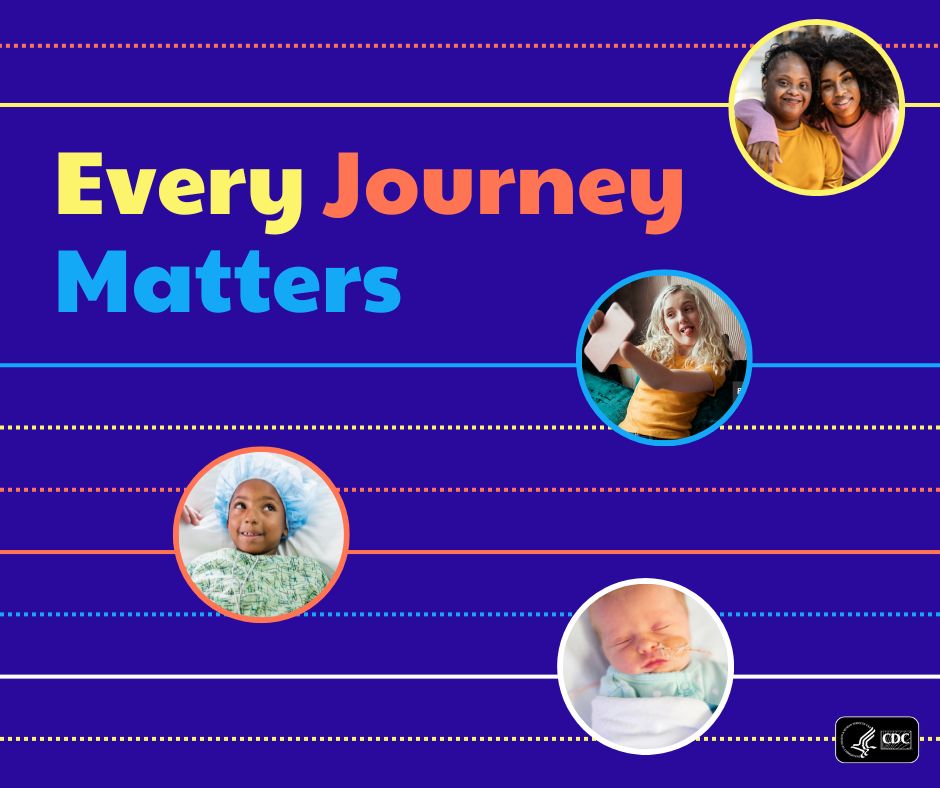National Birth Defects Prevention Study (NBDPS)
The NBDPS is one of the largest studies on birth defects ever undertaken in the United States. This study has made key contributions toward understanding the causes of birth defects and identifying potential risks for having a baby with a birth defect. Learn more about the study.
About NBDPS

The NBDPS is one of the largest studies on the causes of birth defects in the United States. NBDPS researchers study information from babies born between 1997 and 2011. Over the course of 14 years of interviews, 43,000 women from 10 states took part in the study. Interviewing mothers of babies in the study stopped in March 2013, but researchers will continue to analyze this rich source of information on birth defects.
NBDPS has made key contributions toward understanding the risk of having a baby with a birth defect when specific medications are used just before and during pregnancy. Data from NBDPS have demonstrated that mothers who are obese have a much higher risk for having a baby with a number of different major birth defects. The study has also confirmed results from previous studies that found that women who smoke cigarettes during pregnancy have a higher risk of having a baby with a cleft lip, cleft palate, or both. Understanding the risks and causes of birth defects can help us prevent them. This study provides important clues to help us in our journey to ensure that every child is born in the best possible health.
Notable NBDPS Findings
To date, more than 200 scientific papers have been published using data from NBDPS. Some examples of important findings:
Polycyclic Aromatic Hydrocarbons and Oral Clefts – Polycyclic aromatic hydrocarbons (PAHs) are chemicals formed during the burning of coal, oil, gas, garbage, or from smoking cigarettes, cigars, or pipes, or from charbroiling meat. There are many ways to come in contact with PAHs at home or at work. NBDPS researchers looked for evidence of a link between PAHs in a woman’s workplace and oral clefts (clefts of the lip and palate) in their babies.
Among women interviewed for the NBDPS, researchers found that it was not very common for women to work in places with PAHs. PAH exposure occurred most often among women working in food preparation and serving. Pregnant women who worked in places with any PAHs were more likely to have babies with cleft lip with or without a cleft palate. Pregnant women who worked in places with higher PAH levels were even more likely to have babies with cleft lip than women who worked in areas with lower PAH levels. Since this was the first study to show this link, more research is needed to understand it fully.
[Read summary]
Butalbital Use and Birth Defects
Butalbital (byoo-TAL-bi-tal) is an ingredient in some medicines (for example, Fioricet®, Fiorinal®) prescribed for the treatment of migraine and tension-type headaches. Little is known about the safety or risk of using butalbital while pregnant. NBDPS researchers looked to see if there is a link between butalbital use and birth defects.
Researchers found that butalbital use is rare among women in NBDPS. Researchers also found a link between using butalbital while pregnant and certain congenital heart defects . The heart defects in the study with this link include tetralogy of Fallot, pulmonary valve stenosis, and atrial septal defects. This study is the first to show these links. More research is needed to learn more about the risks and benefits of butalbital use among pregnant women.
[Read Summary]

Antiherpetic Medication and Gastroschisis
Gastroschisis is a birth defect of the abdominal (belly) wall. The baby’s intestines are outside of the baby’s body through a hole beside the belly button. The causes of gastroschisis are not known, but it is thought that exposures in early pregnancy might play a key role.
Herpes infections can occur during pregnancy, and to treat these infections antiherpetic medicines are sometimes used. Researchers used NBDPS data to see if antiherpetic medicine use in early pregnancy is linked to the risk of gastroschisis. This study found that the risk of gastroschisis could be higher in children born to women with herpes infection who used antiherpetic medicine. More research is needed to determine the risks of herpes and antiherpetic medications in pregnancy.
[Read Summary]
Genetics and Congenital Heart Defects
Congenital heart defects (CHDs) are the most common type of birth defect, affecting about one in every 100 babies born in the United States. Scientists are working hard to learn the causes of CHDs. Most CHDs are due to a complex relationship among environment, lifestyle, and genetic factors.
Using the genetic samples that NBDPS families provided, NBDPS researchers identified changes (sometimes called variants) in several genes that were linked with CHDs. Variants in four genes were found to increase the risk of heart defects. More research is needed to understand the functions of these genes and to confirm the study findings among different groups. This study is one of the first in NBDPS to study genes from babies and their mothers.
[Read Summary]

Fever in Pregnancy and Congenital Heart Defects
Fever in early pregnancy is common. It is reported by 5% to 10% of women during the first trimester. Congenital heart defects (CHDs) are the most common birth defect. NBDPS researchers looked to see if there is a link between fever during pregnancy and CHDs.
Among mothers of a baby without a birth defect, one out of 13 had a fever in early pregnancy. For mothers of a baby with a CHD, about one in 12 had a fever in early pregnancy. Researchers found that the risk for CHDs was higher if the fever was from a urinary tract infection or pelvic inflammatory disease than if it was from a respiratory, flu-like disease. The increased risk was seen for certain CHD types, such as heterotaxy and some obstructive heart defects. Results of this study suggest the risk for these heart defects might be lower in women who were taking multivitamins before their pregnancy.
[Read Summary]
Air Pollution and Congenital Heart Defects
Many pregnant women, especially those who live in urban areas, are exposed to different air pollutants. Although the Environmental Protection Agency sets air quality standards to limit the amount of pollution in our air, we still do not know whether the amounts of pollution women are exposed to can affect their unborn babies.
NBDPS researchers found that higher exposure to air pollutants related to car traffic, specifically nitrogen dioxide, was more common among mothers of babies born with certain types of congenital heart defects (CHDs). More research is needed to learn what levels of air pollution affect an unborn baby.
[Read Summary]

The Potential Impact of Newborn Pulse Oximetry Screening
In the United States, about 7,200 babies born each year have critical congenital heart disease, also known as CCHD. CCHDs are the most serious types of congenital heart defects (CHDs). CCHDs often lead to low levels of oxygen in a newborn. A low oxygen level in a baby can be found by testing oxygen levels 24 hours after birth.
NBDPS researchers found that about 30% of the babies with CCHDs were diagnosed more than three days after birth. The percentage of babies with more than three days delay in diagnosis varied based on CCHD type—ranging from about 8% for babies with pulmonary atresia to 62% for babies with coarctation of the aorta. If these babies had been tested for CCHD within 24-48 hours of birth, as is now mandated in many state newborn screening programs, some of them might have been diagnosed sooner, leading to earlier treatment.
[Read Summary]
Risk Factors for Choanal Atresia in the NBDPS
Choanal atresia is a narrowing of the nasal airway and can cause severe breathing problems in newborns. It is one of the leading causes of nasal surgery. Choanal atresia is rare, and not much is known about its risk factors. NBDPS researchers looked for reasons that might increase the risk for having a baby with choanal atresia.
Researchers found that the risk of choanal atresia was higher when women smoked cigarettes, had three or more cups of coffee with caffeine every day, or used thyroid medications early in their pregnancy. This study is one of the first to look at risk factors for choanal atresia, so more research is needed to confirm these findings.
[Read Summary]
Participation in the Genetic Component of NBDPS
Most women (63%) who finished an NBDPS phone interview also gave NBDPS genetic samples by providing swabs of their cheek cells. NBDPS researchers found that taking part in the genetics part of the study differed by Center. The participation ranged from 50% to 74% across different sites.
Participation also differed by race/ethnicity. Among white and Hispanic women, those with a higher education and had a baby with a birth defect were more likely to complete the cheek cell collection than women of other races. Among all racial/ethnic groups, an extra $20 incentive and a shorter time between the baby’s due date and the phone interview were linked with women being more likely to participate. Researchers can use this feedback to increase participation in similar studies in the future.
[Read Summary]
NBDPS Video
Learn about the NBDPS from families who have been affected by birth defects, researchers, and doctors.
NBDPS and BD-STEPS Public Access Procedures
Learn about how to apply for access to NBDPS and/or BD-STEPS data.
